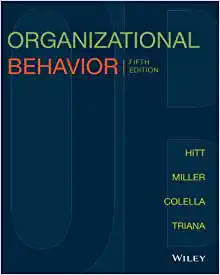This assessment does not deliver good news to one who scores 18 or below on self-efficacy and
Question:
This assessment does not deliver good news to one who scores 18 or below on self-efficacy and 20 or below on tolerance of risk. On the other hand, its stated purpose is to provide information a person can use to understand better how and why they behave as they do in situations of organizational change. The assessment does offer a focus for general learning about low tolerance for change. Rather than ask any learner to reveal low self-efficacy or tolerance, conduct a “what if” scenario.
- How Would This Course Go If All Were Low? The purpose of this exercise is to imagine if, how, and why there would be a difference in the overall quality of their OB learning during this term, were all members (including you) scored as risk averse and low in self-efficacy.
- Develop general consensus in a large group discussion on:
- How the whole course stacks up as a changing organization. Low change? Steady and easy to manage change? Often difficult, but growth-promoting change?
- How strong was resistance to change overall? Little? Modest? A lot? Why?
- How would the course come out overall? Better? The same? Worse? Why?
- Convene teams of 3-5 to apply each of the 19 descriptors to remember their experience in the course. They are looking at each as if they are low in self-efficacy and risk tolerance. They speculate on what sorts of resistance would come from a whole class of “Lows” on each.
- For example. “Enjoy being reckless” is the first item. They might imagine that a low scorer would not want to have tried any of the team exercises that had unpredictable results. There would have been resistance to doing team exercises. Alternatively, “Become overwhelmed by events.” A Low scorer might think the pace of the course is too fast. Resistance would be pressure on the instructor to spend more time on chapters, skipping some.
- When the teams have completed speculating on this extreme scenario, ask them to report several of their most surprising findings about the differences it might make in the overall quality of learning.
Make the transition to the workplace. A strategic value of human capital is that people can create knowledge for innovation faster and better than their competitors can. Each of your learners will be contributing knowledge of this sort in organizations that must change to survive. They can, that is, if they overcome self-doubts and gain experience in taking social risks. They can look back on this exercise as a worst-case scenario and look forward to the best case, which is to work and learn among other high scorers on this assessment.
Step by Step Answer:






